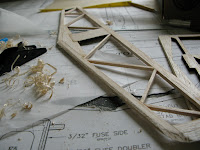I visited the March monthly meeting for chapter 106 of the experimental aircraft association to see a photo presentation by Lane Wallace, scored a signed copy of her book, and met and chatted with several experienced aircraft builders at the meeting including Mr. Richard Gersh, a VP of Business Development at Terrafugia. Mr. Gersh let us know that Terrafugia is planning to show their prototype at the NY auto show, and that they would have a photo-op session in Times Square on the way to the show on April 1st. I also heard about the Charles River RC club at the meeting, and Wick's aircraft supply and aircraft spruce, where you can find just about everything you need to build a plane.
After meeting the flying folks, and sizing up the offerings at MIT, I've wondered again if there might already be flying motorcycles out there that I haven't heard of. There are at least two companies with candidate prototypes for flying/road-going automobiles: Terrafugia’s Transition, and the Dutch PAL-V. There's a January 29, 2012 article about the Terrafugia transition in CNN, a great TED talk by co-founder Anna Mracek Dietrich, and a promo video for their 'roadable aircraft'. I don't know as much about the PAL-V, but I'm certainly interested in their propeller. Check out the videos and websites of both aircraft below if you're further interested.
There are several other interesting contenders for neat ways to get around, including Moller’s Skycar, Samson Motorworks’ Switchblade, the Hover-bike. Some have also stowed collapsible motorcycles into regular small aircraft, but in addition to added weight, this design deprives the pilot of the great outdoors. Drifting further away from flying motorcycles, there are also human bird wings, vacuum tunnels, and super fuel efficient planes. All of these are unfortunately not two-wheeled road-going aircraft, i.e. motorcycles, though. How does that make us feel?
Strangely enough, some of the wilder motorcycle folks around have even mounted a turbine engine to two wheels, resulting in a motorcycle which can outrun a MIG fighter on a runway, but for some reason they didn't bother to go the extra mile and attach wings. WTF guys?! There are all sorts of badass custom motorcycles around, so where are the wings already?! Oh yeah, I guess that's me huh?
You decide which of these best describes my feelings about there being no flying motorcycles in the world.
Strangely enough, some of the wilder motorcycle folks around have even mounted a turbine engine to two wheels, resulting in a motorcycle which can outrun a MIG fighter on a runway, but for some reason they didn't bother to go the extra mile and attach wings. WTF guys?! There are all sorts of badass custom motorcycles around, so where are the wings already?! Oh yeah, I guess that's me huh?
On the bright side, the glider is well on it's way to flying high. Somehow, the designer didn't include AILERONS, which I guess is maybe a standard 2 meter glider thing? Maybe it's more badass if you can fly with only two control axes? Well between you and me, I think it will be bad enough ass to be flying a motorcycle, and there will probably be enough problems and challenges even with all three axes, so I'm modifying the plans to include ailerons. And while I'm at it, maybe I'll skin the whole thing in a super lightweight fiberglass instead of monokote or that polyolefin heat shrink roll I bought. Turns out polyolefin is great for labeling bottled beer, but isn't quite elastic enough for skinning a plane. Oh well.
Photos of glider progress at my secret lair in New Hampshire
Until next time, maybe I'll check out some sky diving lessons to tack onto my flying lesson which I still haven't gotten around to. Hopefully the warmer spring weather will bring me around to the airfield soon so that I can do both in short order. Probably the X-plane and turboCAD orders can wait until the fall when I'll want to spend more time inside again, and hash out some patents or something right? When the time comes, it looks like a raspberry pi (available at Newark.com), might make for a nice lightweight flight computer, but for now I think I'll be OK with my 2.4GHz radio and servos. Anyway, I'll do my best to have the glider operating next time!
FOLLOWUP EDIT: Thanks to Ron for pointing out DIY Drones and their ArduPilotMega Arduino powered programmable autopilot! This is quite an amazing package for $200: a MediaTek MT3329 10Hz GPS, a Honeywell HMC5843 3-axis digital magnetometer compass, an Invensense MPU-6000 six-axis gyro and accelerometer, a Swiss temperature corrected barometric altimeter, all of these are digital too! There's even a little pitot tube addon so you can do airspeed feedback. Rad.


